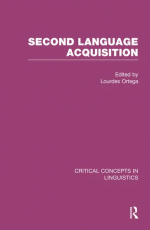Tab Article
Second-language acquisition was born in the late 1960s as an interdisciplinary enterprise that borrowed equally from the feeder fields of linguistics, language teaching, child language acquisition, and psychology. Since then, it has expanded considerably in scope and methodology to the point that for many, by the end of the twentieth century, it had finally reached its coming of age as an autonomous discipline, a discipline that today is more than ever undergoing change, renovation, and expansion.
This six-volume collection, a new title in Routledge’s Critical Concepts in Linguistics series, offers a comprehensive survey of this burgeoning field, its accumulated findings and proposed theories, its developed research paradigms, and its pending questions for the future. Including both classical and cutting-edge research, the collected materials offer a cogent and nuanced panoramic of the past, present, and future of second-language acquisition research.


